Kiwifruit Market Overview猕猴桃市场概况中英文
Kiwifruit, sometimes known as Chinese gooseberry, or simply “kiwi,” is thought to have been discovered in various regions of China and was considered a delicacy among royals.
Seeds from China were introduced to New Zealand in the 1900s and were exported to the United States in the 1950s.
The most common variety is a green kiwi, the Hayward, grown almost exclusively in California and originating from the first known plants exported from New Zealand.
Green kiwis are fuzzy and brown with bright green flesh and tiny black seeds. The fruit grows on a woody vine that can reach up to 30 feet tall.

▲Golden Kiwi Orchard
猕猴桃市场概况
猕猴桃,有时被称为中国醋栗,或简称为“猕猴桃”,被认为在中国各地都有发现,被认为是皇室成员的美味佳肴。
20世纪初,中国的种子被引入新西兰,并在20世纪50年代出口到美国。
最常见的品种是一种绿色猕猴桃,海沃德,几乎只在加利福尼亚州种植,起源于新西兰出口的第一批已知植物。
绿色的几维鸟毛茸茸,呈棕色,果肉呈亮绿色,种子呈黑色。这种水果生长在高达30英尺的木本藤蔓上。

▲yellow Kiwifruit
Types & Varieties of Kiwifruit
There are several types of kiwifruit: grocery store green kiwifruit (Actinidia deliciosa), yellow or gold kiwis (Actinidia chinensis), hardy kiwifruit (Actinidia arguta), and super-hardy kiwifruit (Actinidia kolomikta).
Green kiwifruit is the most common but yellow kiwis are gaining popularity due to their smoother, edible skin.

▲Red kiwifruit
猕猴桃的种类和品种
猕猴桃有几种类型:杂货店的绿色猕猴桃(美味猕猴桃)、黄色或金色猕猴桃(中华猕猴桃)、耐寒猕猴桃(阿尔瓜猕猴桃)和超耐寒猕猴桃(科洛米克塔猕猴桃)。
绿色猕猴桃是最常见的,但黄色猕猴桃因其更光滑、可食用的皮肤而越来越受欢迎。
Hardy kiwifruit, known as “bowerberry,” grows on trees that can reach 100 feet tall in the forests of Japan, China, Korea, and Siberia, where they are able to withstand colder temperatures. The fruit is smooth-skinned, quite sweet, and grows in clusters like grapes.
The super-hardy kiwi is also smooth-skinned with even smaller fruit and can handle temperatures to -40°F in winter. It is sometimes called the “arctic beauty kiwifruit.”
耐寒猕猴桃,被称为“接骨木莓”,生长在日本、中国、韩国和西伯利亚森林中高达100英尺的树木上,在那里它们能够承受更冷的温度。这种水果皮光滑,很甜,像葡萄一样成簇生长。
这种超级耐寒的几维鸟皮肤光滑,果实更小,冬天可以承受-40°F的温度。它有时被称为“北极美人猕猴桃”
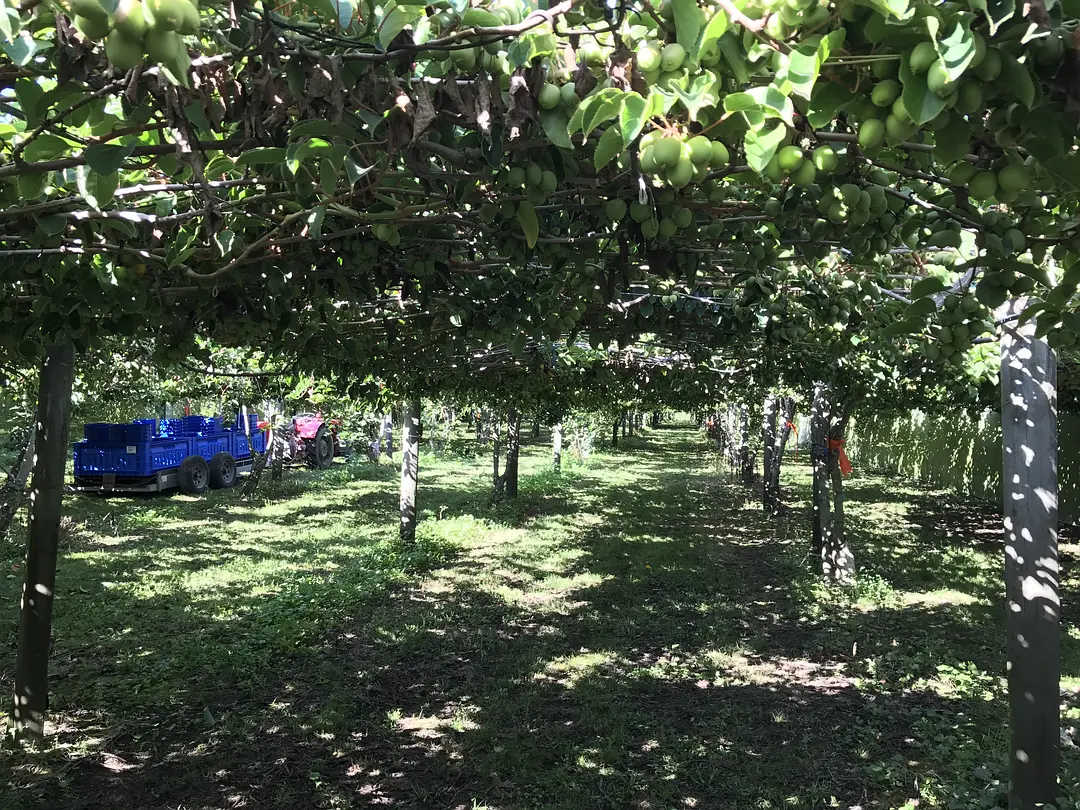
▲Golden kiwi growing zone
There are more than forty known varieties of kiwi, spanning the globe from California to New Zealand to Greece, though the Hayward remains the standard for most commercial growers.
In areas where there are growing limits due to colder temps, the Saanicheton variety has been known to survive where the Hayward has not. Other varieties include Elmwood, Dexter, Tewi, Vincent, Matua, Tomuri, Allison, Abbott Bruno, Gracie, and Monty.
猕猴桃有40多种已知品种,从加利福尼亚州到新西兰再到希腊,遍布全球,尽管海沃德仍然是大多数商业种植者的标准。
在由于气温较低而限制生长的地区,已知Saanicheton品种在Hayward没有的地方存活下来。其他品种包括Elmwood、Dexter、Tewi、Vincent、Matua、Tomuri、Allison、Abbott Bruno、Gracie和Monty。

▲Winter pruning of kiwifruit orchard
Cultivation of Kiwifruit
Kiwifruit can grow wherever citrus, peaches, and almonds are plentiful, but its leaves are more sensitive to cold than orange or peach trees. Young kiwifruit vines are killed by drops in temperature below 29°F, while mature vines can withstand temperatures below 10°F.
For healthy growth, plants need deep, fertile, moist, and well-drained soil. Flowers of the plant are almost exclusively pollinated by insects. Kiwifruit is harvested by hand in a single pick once fruit has reached maturity.
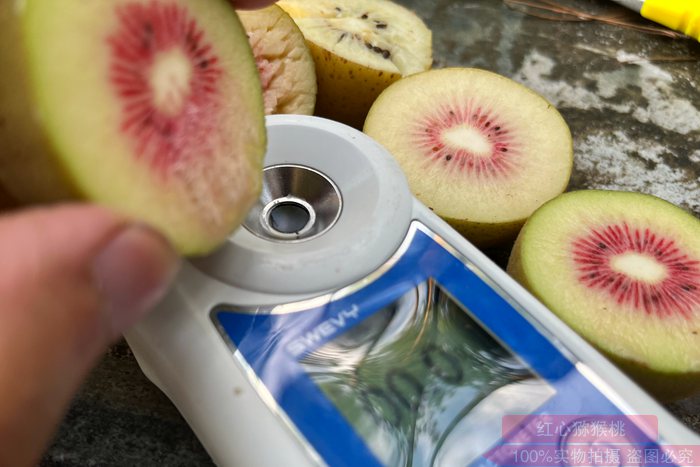
▲红心猕猴桃成熟度检测
猕猴桃的栽培
猕猴桃可以生长在柑橘、桃子和杏仁丰富的地方,但它的叶子比橘子或桃树对寒冷更敏感。当温度降至29°F以下时,年轻的猕猴桃藤会死亡,而成熟的猕猴桃藤可以承受10°F以下的温度。
为了健康生长,植物需要深厚、肥沃、湿润和排水良好的土壤。这种植物的花朵几乎完全由昆虫授粉。猕猴桃成熟后,一次采摘就可以手工采摘。

▲A kiwi orchard with abundant fruits
Pests & Diseases Affecting Kiwifruit
Rootknot nematodes are parasitic worms that attack the roots of plants, causing “knots” to form. The leafroller caterpillar (the most common and damaging pest) will eat holes in the fruit causing scarring, especially where two or three fruits are touching each other.
In summer or early fall, thrips can cause browning of the leaves. Greedy scale insects infest the leaves, bark, and fruit, killing the growth tips. The boxelder bug tends to feed on the buds and fruit, causing deformities and fruit drop.

▲redkiwifruit
影响猕猴桃的病虫害
根结线虫是一种寄生蠕虫,攻击植物根部,形成“结”。卷叶虫(最常见和最具破坏性的害虫)会吃掉果实上的洞,造成疤痕,尤其是在两三个果实相互接触的地方。
在夏天或初秋,蓟马会导致叶子变褐。贪婪的蚧虫侵扰树叶、树皮和果实,杀死生长尖端。黄杨虫倾向于以芽和果实为食,导致畸形和落果。

▲Training on Pollination Techniques for Kiwi Orchard
Crown gall affects vines and can be avoided by leaving the upper roots exposed. Roots can also be attacked by phytophthora cactorum and P. cinnamomi, along with oak root fungus, which cause root rot, killing the entire plant.
Botrytis cinerea affects both the flowers and the fruit and has been found in most growing areas. The biggest threat to kiwis is postharvest grey mold rot, which enters the skin through small cracks when stored at high humidity.
Kiwifruit vine disease (more common in Europe) is a bacterial cancer that causes halo-shaped spots on leaves, brown discoloration of buds, and release of a red-colored gum on the plant. The disease is spread through windborne pollen, heavy rainfalls, humans, and animals, and is most apparent during cooler temperatures and high humidity.

▲helping growers achieve their ultimate pollination
冠瘿会影响藤蔓,可以通过暴露上部根系来避免。根也会受到仙人掌疫霉和肉桂疫霉的攻击,以及橡树根真菌,这些真菌会引起根腐病,杀死整个植物。
灰霉病影响花朵和果实,在大多数种植区都有发现。猕猴桃面临的最大威胁是采后灰霉病,在高湿度下储存时,灰霉病会通过小裂缝进入皮肤。
奇异果藤本病(在欧洲更常见)是一种细菌性癌症,会导致叶片上出现盐状斑点,芽变色,并在植物上释放红色树胶。这种疾病通过风媒花粉、大雨、人类和动物传播,在较冷的温度和较高的湿度下最为明显。
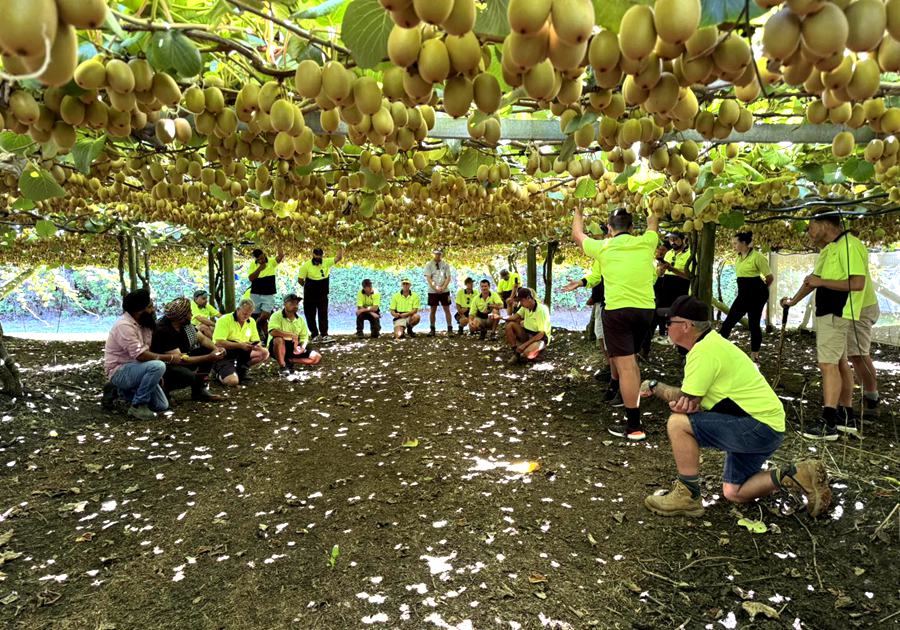
▲Harvest Sunshine Golden Fruit Kiwi Orchard
Storage & Packaging of Kiwifruit
They are packed in single-layer flats, with some fruit being placed in small consumer bags. Kiwifruit should be stored at 32°F with 90 to 95% relative humidity. Freezing injury can occur in colder temperatures.
Fruit is extremely susceptible to the effects of ethylene; use of controlled-atmosphere storage facilities is helpful for long-term storage to avoid its own production of the gas.
References: California Kiwifruit Commission, California Rare Fruit Growers, New Zealand Ministry for Primary Industries, Oregon State University, Purdue University, UC Davis Integrated Pest Management, UC Davis Postharvest Technology Center, University of Arkansas, USDA.
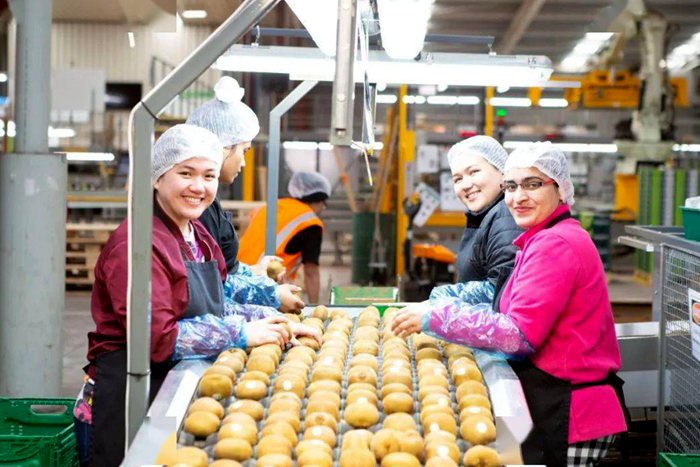
▲新西兰佳沛猕猴桃包装厂照片
猕猴桃的储存与包装
它们被包装在单层公寓里,一些水果被放在小的消费袋里。猕猴桃应储存在32°F、相对湿度为90%至95%的环境中。冻伤可能发生在较冷的温度下。
水果极易受到乙烯的影响;使用可控气氛储存设施有助于长期储存,避免自身产生气体。
参考文献:加州猕猴桃委员会、加州珍稀水果种植者、新西兰第一产业部、俄勒冈州立大学、普渡大学、加州大学戴维斯分校综合虫害管理、加州大学Davis收获后技术中心、阿肯色大学、美国农业部。
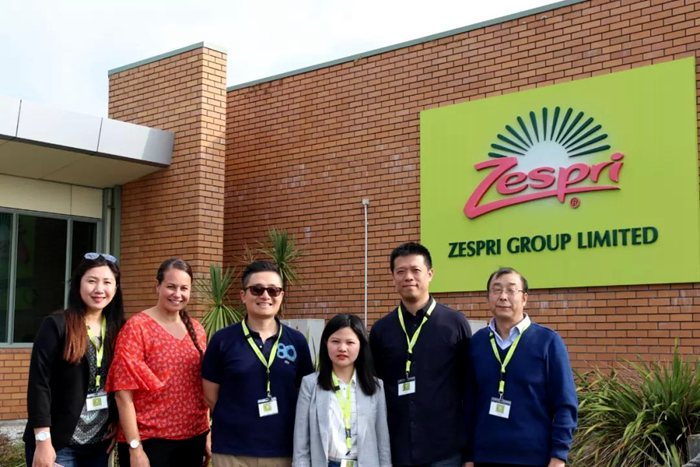
▲国内猕猴桃业者参观佳沛总部
Grades & Good Arrival of Kiwifruit
Kiwifruit is categorized as U.S. Fancy, U.S. No. 1, and U.S. No. 2. All require fruit to have similar varietal characteristics, be mature, not soft, overripe, or shriveled, and to be carefully packed. For U.S. Fancy, the fruit must also be clean and well-formed. All three grades stipulate fruit be free from worm holes, broken unhealed skin, sunscald, freezing injury, internal breakdown, and decay.

▲Harvest Sunshine Golden Fruit Kiwi Orchard
猕猴桃的等级和到货情况
猕猴桃被归类为美国花式、美国第一和美国第二。所有这些都要求水果具有相似的品种特征,成熟,不软,过熟或枯萎,并仔细包装。对于美国花式,水果也必须干净且形状良好。这三个等级都规定水果没有虫洞、破损未愈合的皮、日晒、冻伤、内部破裂和腐烂。

▲Zunyi Bohong Kiwi Fruit Industry Co., Ltd. is the largest kiwi fruit industry company in Guizhou Province, planting 1200 acres of high-altitude kiwifruit. It is a leading agricultural enterprise in Zunyi City and an advanced poverty alleviation enterprise at the municipal level. The kiwi pollen project is the largest single area macaque peach blossom pollen orchard in China, with a single pollen collection area of 400 acres. During the high-yield period, 400 kilograms of pollen are produced, providing high-quality, high ploidy, and high activity kiwi pollen that can meet the pollen needs of 30000 acres of orchards. Contact WeChat 18030405084 tel 86 18030405084



评论